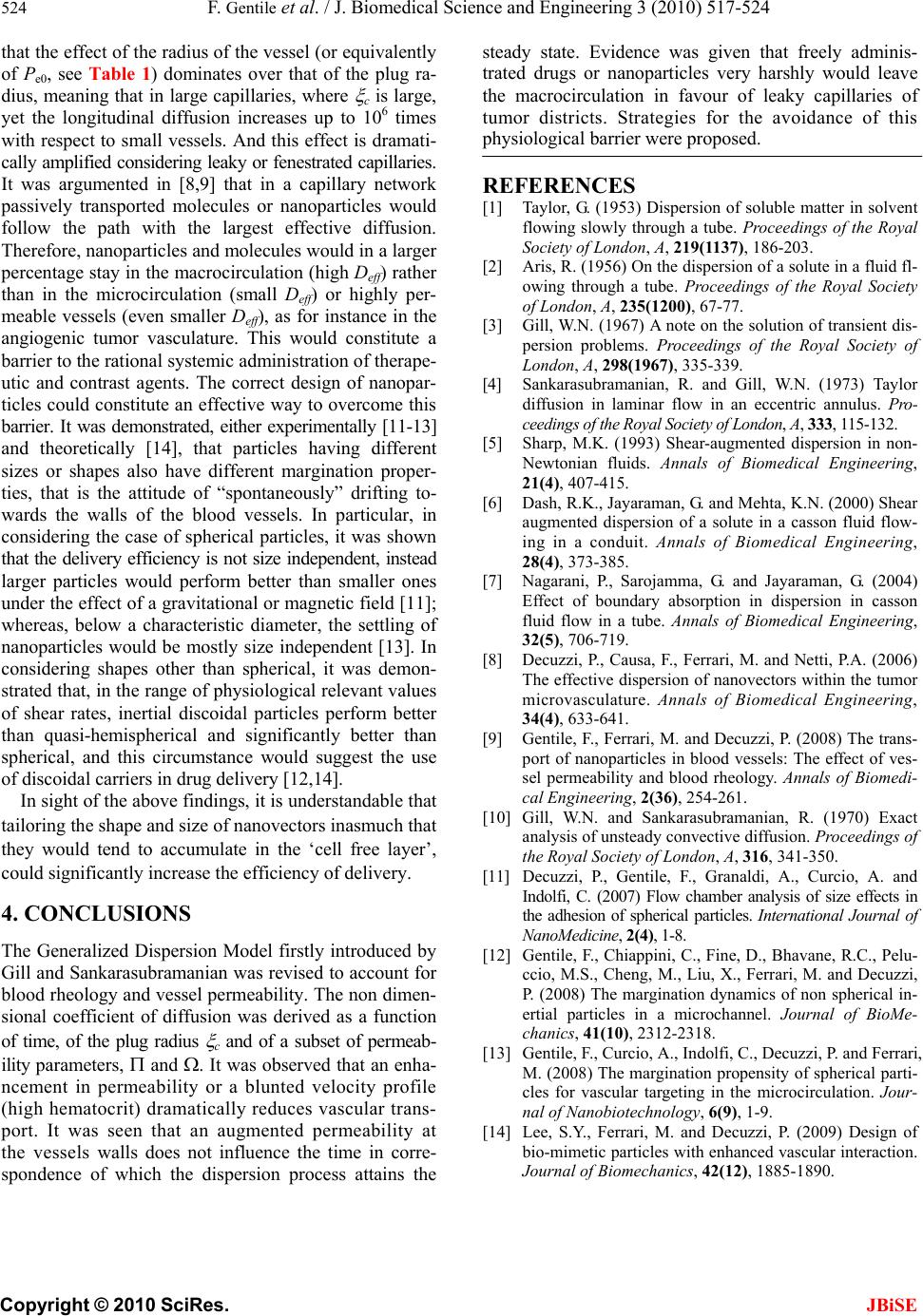
524 F. Gentile et al. / J. Biomedical Science and Engineering 3 (2010) 517-524
Copyright © 2010 SciRes.
that the effect of the radius of the vessel (or equivalently
of Pe0, see Table 1) dominates over that of the plug ra-
dius, meaning that in large capillaries, where
c is large,
yet the longitudinal diffusion increases up to 106 times
with respect to small vessels. And this effect is dramati-
cally amplified considering leaky or fenestrated capillaries.
It was argumented in [8,9] that in a capillary network
passively transported molecules or nanoparticles would
follow the path with the largest effective diffusion.
Therefore, nanoparticles and molecules would in a larger
percentage stay in the macrocirculation (high Deff) rather
than in the microcirculation (small Deff) or highly per-
meable vessels (even smaller Deff), as for instance in the
angiogenic tumor vasculature. This would constitute a
barrier to the rational systemic administration of therape-
utic and contrast agents. The correct design of nanopar-
ticles could constitute an effective way to overcome this
barrier. It was demonstrated, either experimentally [11-13]
and theoretically [14], that particles having differen
si r-
tie -
wn
ould leave
th
REFERENCES
rsion of soluble matter in solvent
Proceedings of the Royal
ayaraman, G. (2004)
be. Annals of Biomedical Engineering,
JBiSE
t
zes or shapes also have different margination prope
s, that is the attitude of “spontaneously” drifting to
ards the walls of the blood vessels. In particular, i
considering the case of spherical particles, it was shown
that the delivery efficiency is not size independent, instead
larger particles would perform better than smaller ones
under the effect of a gravitational or magnetic field [11];
whereas, below a characteristic diameter, the settling of
nanoparticles would be mostly size independent [13]. In
considering shapes other than spherical, it was demon-
strated that, in the range of physiological relevant values
of shear rates, inertial discoidal particles perform better
than quasi-hemispherical and significantly better than
spherical, and this circumstance would suggest the use
of discoidal carriers in drug delivery [12,14].
In sight of the above findings, it is understandable that
tailoring the shape and size of nanovectors inasmuch that
they would tend to accumulate in the ‘cell free layer’,
could significantly increase the efficiency of delivery.
4. CONCLUSIONS
The Generalized Dispersion Model firstly introduced by
Gill and Sankarasubramanian was revised to account for
blood rheology and vessel permeability. The non dimen-
sional coefficient of diffusion was derived as a function
of time, of the plug radius
c and of a subset of permeab-
ility parameters, and . It was observed that an enha-
ncement in permeability or a blunted velocity profile
(high hematocrit) dramatically reduces vascular trans-
port. It was seen that an augmented permeability at
the vessels walls does not influence the time in corre-
spondence of which the dispersion process attains the
steady state. Evidence was given that freely adminis-
trated drugs or nanoparticles very harshly w
e macrocirculation in favour of leaky capillaries of
tumor districts. Strategies for the avoidance of this
physiological barrier were proposed.
[1] Taylor, G. (1953) Dispe
flowing slowly through a tube.
Society of London, A, 219(1137), 186-203.
[2] Aris, R. (1956) On the dispersion of a solute in a fluid fl-
owing through a tube. Proceedings of the Royal Society
of London, A, 235(1200), 67-77.
[3] Gill, W.N. (1967) A note on the solution of transient dis-
persion problems. Proceedings of the Royal Society of
London, A, 298(1967), 335-339.
[4] Sankarasubramanian, R. and Gill, W.N. (1973) Taylor
diffusion in laminar flow in an eccentric annulus. Pro-
ceedings of the Royal Society of London, A, 333, 115-132.
[5] Sharp, M.K. (1993) Shear-augmented dispersion in non-
Newtonian fluids. Annals of Biomedical Engineering,
21(4), 407-415.
[6] Dash, R.K., Jayaraman, G. and Mehta, K.N. (2000) Shear
augmented dispersion of a solute in a casson fluid flow-
ing in a conduit. Annals of Biomedical Engineering,
28(4), 373-385.
[7] Nagarani, P., Sarojamma, G. and J
Effect of boundary absorption in dispersion in casson
fluid flow in a tu
32(5), 706-719.
[8] Decuzzi, P., Causa, F., Ferrari, M. and Netti, P.A. (2006)
The effective dispersion of nanovectors within the tumor
microvasculature. Annals of Biomedical Engineering,
34(4), 633-641.
[9] Gentile, F., Ferrari, M. and Decuzzi, P. (2008) The trans-
port of nanoparticles in blood vessels: The effect of ves-
sel permeability and blood rheology. Annals of Biomedi-
cal Engineering, 2(36), 254-261.
[10] Gill, W.N. and Sankarasubramanian, R. (1970) Exact
analysis of unsteady convective diffusion. Proceedings of
the Royal Society of London, A, 316, 341-350.
[11] Decuzzi, P., Gentile, F., Granaldi, A., Curcio, A. and
Indolfi, C. (2007) Flow chamber analysis of size effects in
the adhesion of spherical particles. International Journal of
NanoMedicine, 2(4), 1-8.
[12] Gentile, F., Chiappini, C., Fine, D., Bhavane, R.C., Pelu-
ccio, M.S., Cheng, M., Liu, X., Ferrari, M. and Decuzzi,
P. (2008) The margination dynamics of non spherical in-
ertial particles in a microchannel. Journal of BioMe-
chanics, 41(10), 2312-2318.
[13] Gentile, F., Curcio, A., Indolfi, C., Decuzzi, P. and Ferrari,
M. (2008) The margination propensity of spherical parti-
Jou
cles for vascular targeting in the microcirculation. Jour-
nal of Nanobiotechnology, 6(9), 1-9.
[14] Lee, S.Y., Ferrari, M. and Decuzzi, P. (2009) Design of
bio-mimetic particles with enhanced vascular interaction.
rnal of Biomechanics, 42(12), 1885-1890.